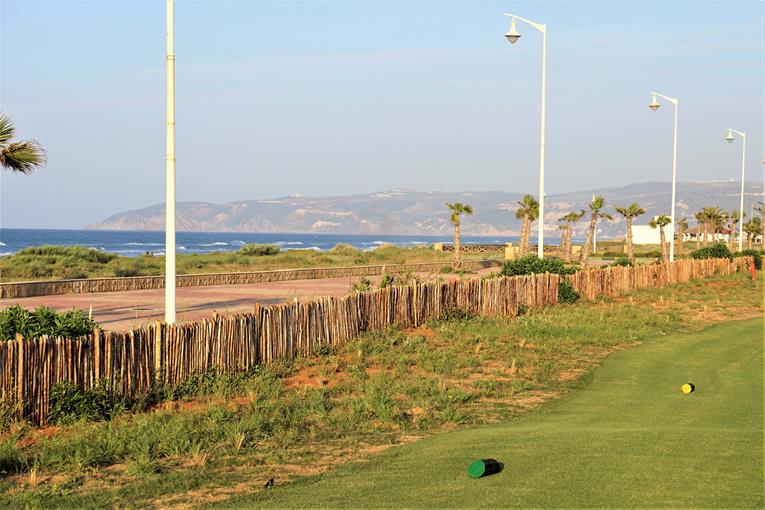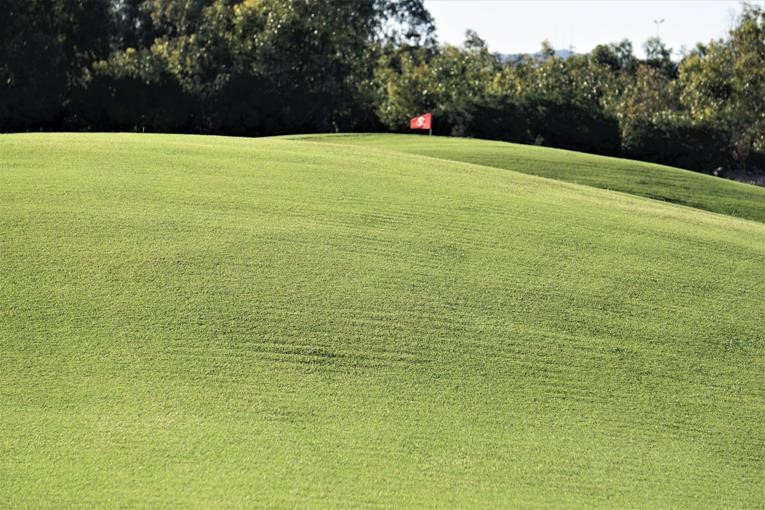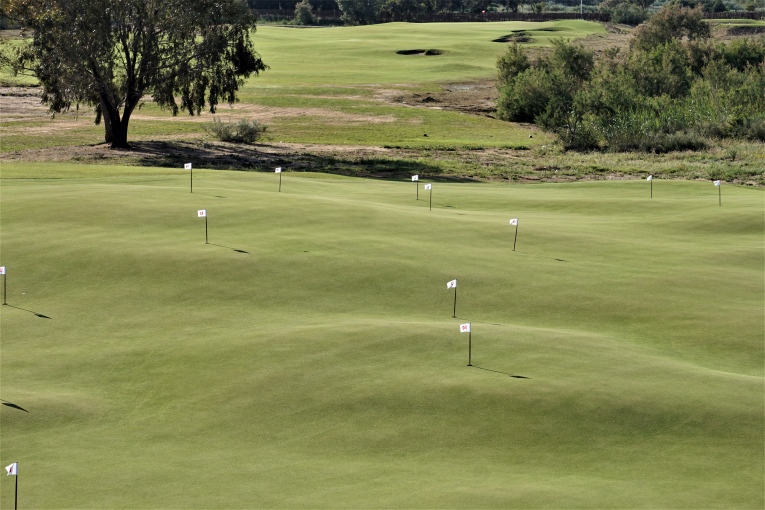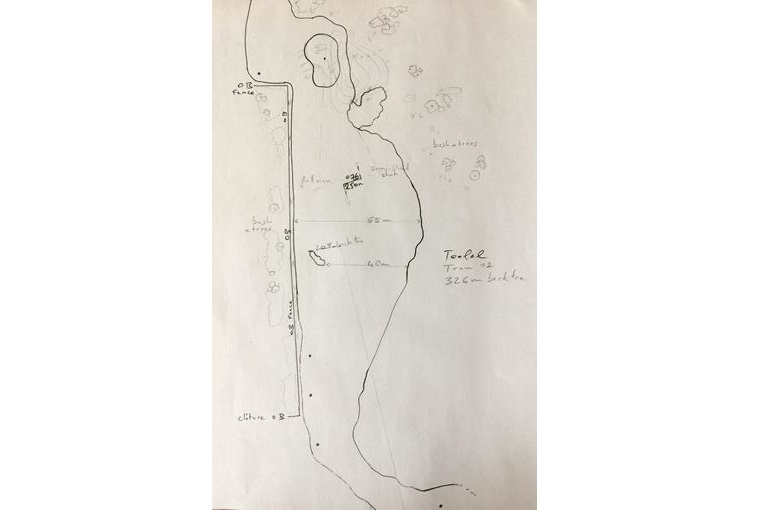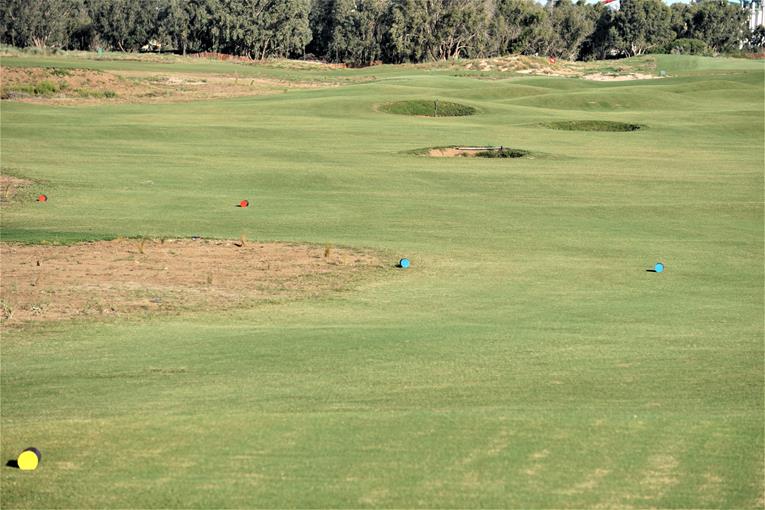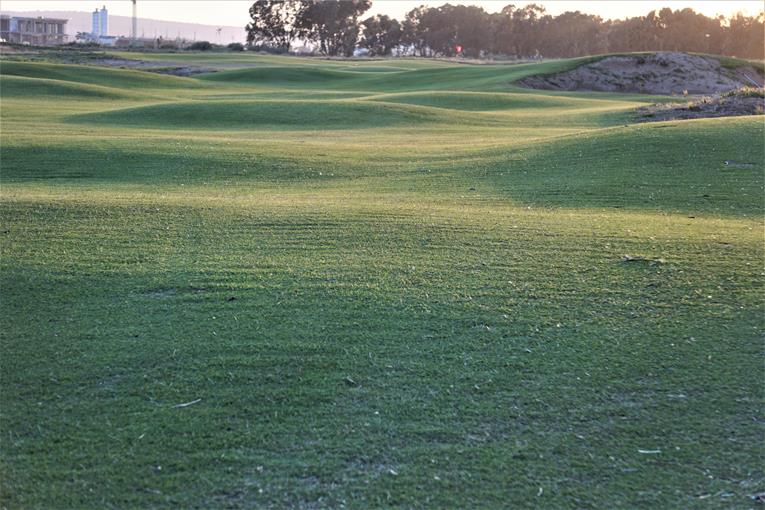Teelal – Golf Saïdia
Morocco
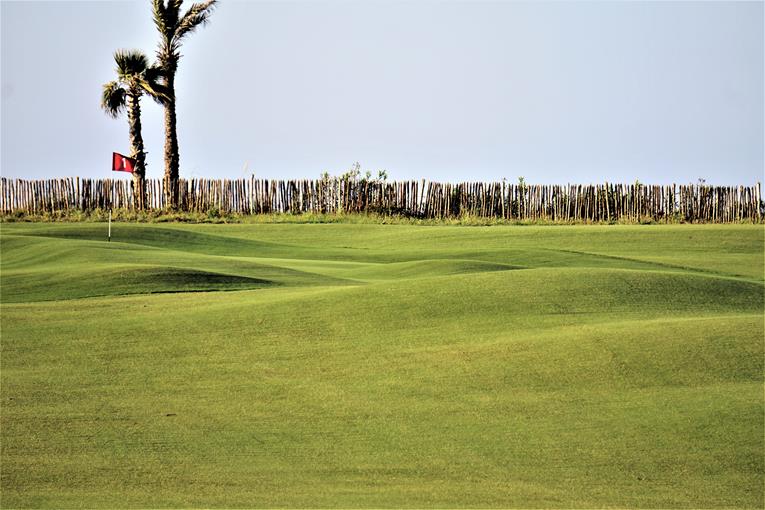
The crumpled land in the foreground says Scotland; the 85 degree temperature, bright sunshine and palm trees in the background suggest otherwise!
Geoff Shackelford’s The Good Doctor Returns is a delightful read about the return of Alister MacKenzie and his take on the game. It is fiction, not only because MacKenzie has not arisen nor if he had, would he be given a chance to work in California’s low coastal dunes. If ever there was a subject matter of fiction, that is it! Elsewhere in the world, Walter Mitty stories do come true; like the golf that French-based architect Nicolas Joakimides created along the sea in eastern Morocco for the Saïdia Resort.
The story begins in 2015 when Joakimides, a professional golfer, played in a pro-am at Saïdia Resort’s original course Saïdia Lakes, an inland design that features – you guessed it – ponds and trees. After the round, he struck up a conversation with the General Manager, Nabil Kadmiri, who mentioned that the resort was considering a second course on property that was highlighted by 330 yards of coastal exposure along the Saïdia beach and boardwalk. Naturally, Joakimides was quite keen, and stayed in touch with Kadmiri. Later in 2016, he was overjoyed to learn that he had the go-ahead! Of utmost interest was forty-five prime acres over small dunes with only the screech of sea gulls to distract the player. The remainder of the course would occupy 138 acres, removed by 600+ yards from the sight and sound of the water but nonetheless enjoying similar attractive micro-movement in the land.
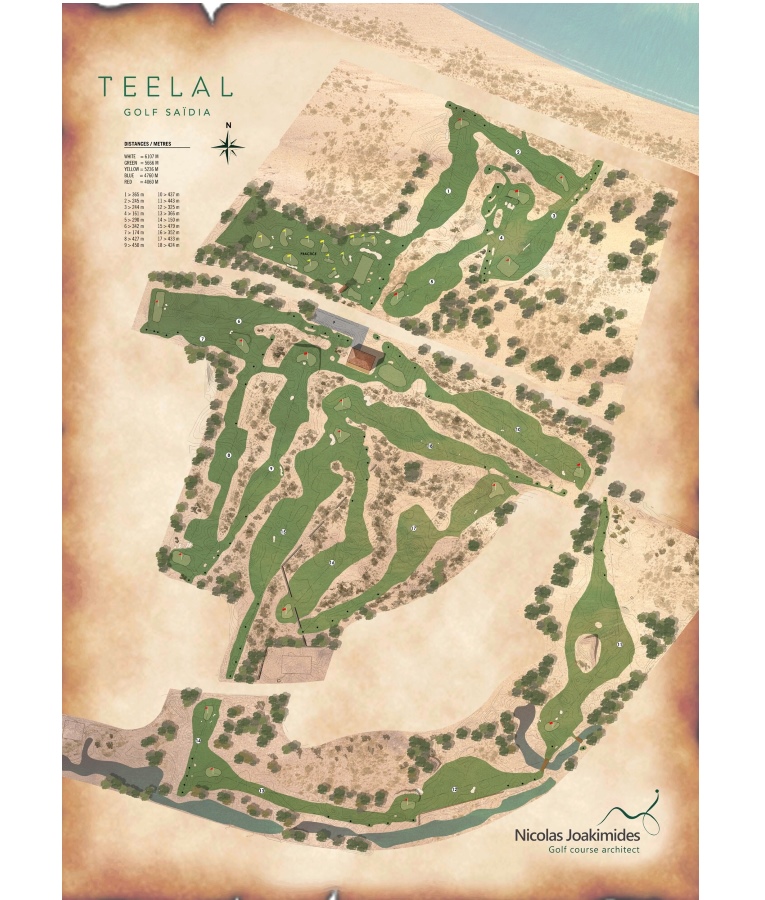
The practice field and first five holes are coastal in nature as they rub alongside Saïdia beach. Holes 6-10 and 15-18 wander to and fro from the clubhouse while 11-14 loop through homes.
When it came time to commence, Kadmiri put his trust in Joakimides, surmising that the eager Frenchman would pour his heart and design ideas into the course. Joakimides describes the opportunity in his Feature Interview on GolfClubAtlas (which can be read here in its entirety):
It was unbelievable, especially once I realized that I had 330 yards along Saïdia beach and that it was all sand. On my first visit, I met sheep on the land – what a good sign! Small undulations existed which were perfect for golf (‘teelal’ is small dunes in Arabic). Five of the holes play near the sea and the rest are inland with four holes going through existing homes. The good news there was that the corridor between homes was 160 yards wide and we have planted 500 trees on the sides. I had a Pinehurst N 2 look in my mind for these holes. No tree is within 20 yards of a fairway. Trees grow fast here, so I am confident that the players will soon only see a large fairway, sand on the side with wire grass, and trees on those four holes and not homes. The general manager really trusted me and let me do what I wanted. I had no restrictions except the clubhouse position. For example, they were okay to build a 400 yards long stone wall as long as I was within the budget. I just had to explain why I needed it that long on 16 but it gives the course an old world feel right away.Overall, this course will play as a links but will take you through three different scenery : beach grass until h 6 , broom from 7 to 10, trees from 11 to 14 and broom again to 18. I like this variety and it reminds me of Chiberta and Moliets in France (and makes me think of Cypress Point). I had enough land so that no two holes in a row go in the same direction and I just feel very lucky to have had this opportunity.
The key was to bring the luscious playing qualities of the coastal terrain across the street to the clubhouse side. The letdown that one experiences moving away from the water at Spyglass Hill was not allowed to occur here. Joakimides had Mother Nature in his favor. The central and southern sections of the course are just as windy and exposed as the coastal holes. Additionally, while the high to low variance in the central section was a mere seven feet, it did feature sandy, windswept landforms that Joakimides could amplify. And he did, not only through constant communication with the construction team that had built the first course but by shaping with an excavator himself.
As he explained in his July 2018 Feature Interview,
I didn’t need much time to build a green or a bunker I had plenty of time to think about it before we began construction. I start with an idea on paper: a sketch. As I begin the actual shaping, things evolve and I make tweaks until I am happy with it and I think that it will produce the best golf. If I don’t feel totally satisfied, I take my time to re-think and finish it until it appeals. That is the benefit of having an architect on site that does his own shaping. [In regards to the random fairway contours], I explained to the Moroccan dozer driver what I wanted and showed him a few sketches. His french was average so sometimes to make him understand I had to draw it in the sand. After his work was finished, I came along with the excavator and re-worked here and there some large undulations and separated them into three smaller ones. I was careful to never repeat myself in this process. It would have been boring otherwise. I really enjoy creating original movement.
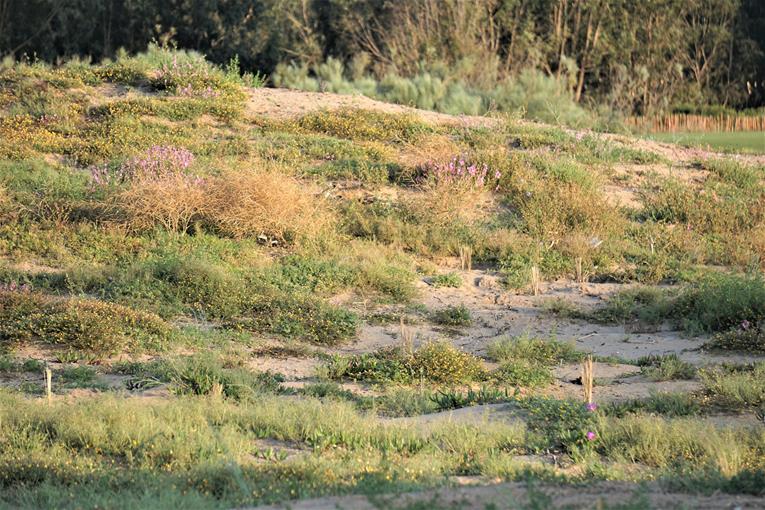
The first five holes weave around and over small dunes (Teelal in Arabic) and constitute a terrific start.
Joakimides spent nearly 150 days on site during planning and overseeing the construction and shaping much of the finer work himself, including all eighteen putting surfaces. As a person, Joakimides is thoughtful and respectful. He embraces a spiritual aspect to life and believes that golf can help improve one’s life. Without a doubt, the course would represent his vision. Yet, since this is only his second course, what exactly is that vision? What did hope to accomplish here? He states, ‘For Teelal, I wanted to have a links course, fun to play, where the ground game is favored so that it’s very playable for the average player. If after the round, they are eager to go again, then I will have succeeded.’ In that pursuit, he avoided narrow, cramped corridors, tightly bunkered greens that dictate an aerial approach that only the tiger can handle, and was leery of length for length’s sake. Instead, he favored short grass, random contours, and bunkerless green complexes with an especial ‘tip of the hat’ to punchbowl style greens.
Ultimately, his design challenges the resort guest and by rewarding good play he believes he can inspire people to fall in love with the sport. Of course, the idea of making golf fun and enjoyable is nothing new. No golf architect has ever stated, ‘I am going to break the player.’ Architects know more than anyone that the easiest type hole to build is a hard one; there is no mystery nor art in making a hole unreasonable. The popular concept of the 1960s-1980s, ‘a hard par and an easy bogey’ doesn’t address the need to think, have anything to do with how the holes relate to each other nor the variety of shots required of a golfer over a round.
Let’s take a look at how Joakimides addressed the dilemma that is faced by every architect: How to find the balance between fun and challenge. Take his seventh hole, aptly named Punchbowl after one of his favorite features. It’s 190 yards from the back, inland and runs parallel to the shore. The wind is capricious, changing during the day. Joakimides created six foot ‘dunes’ (a.k.a. mounds) so that the green could be situated in an attractive hollow. A solitary bunker is short left, well removed from the putting surface and on the side opposite to the miss of most high handicappers. As is his inclination, tight short grass surrounds the green. As a punchbowl does, short grass funnels balls onto the green from the left and right. Several ways exist for the golfer to experience a good news event so, in a unique twist to insure the hole wasn’t too easy, Joakimides built up the middle section of the green. As can be discerned from the sketch and photograph below, if the flag is located on this elevated mound, the target becomes quite small for the tiger. To Joakimides’s merit as a player, the author witnessed him hit it to three feet!
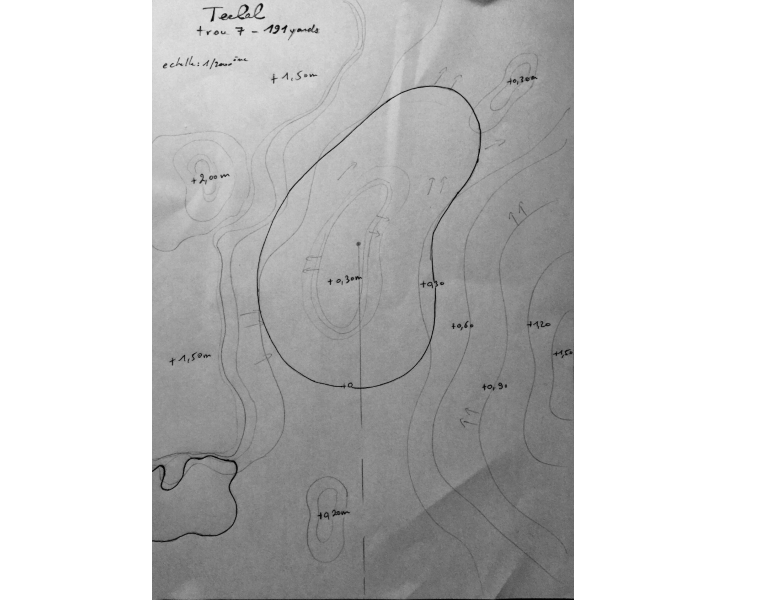
Not only are there mounds left and right, there is also a raised section in the peanut shaped green.
The middle and high handicapper will often be near or on the seventh green, so that their second shots are likely with a putter, though two putts are far from given. An accomplished player might aim 40 yards (!) in a different direction when the wind and hole location change. Bouncing the ball off either the left dune or the right one is a distinct option as is playing a fade or draw to suit the day’s conditions. In short, the seventh is an inordinately flexible hole, one that the golfer won’t tire of playing during his multi-day stay at the resort. The tiger might be asked to hit an exacting shot but the rest of us have fun too – a design ‘win’ in every respect.
Another aspect of the mirth created by Joakimides is the Atlas putting green, named so after Morocco’s mighty mountain range that extends into Algeria and Tunisia. More compact than either the Himalayas Putting Course at St. Andrews or Thistle Dhu in Pinehurst, this practice putting green offers rollicking action in a confined space. It reminds the author of a Perry Maxwell green: how can someone cram so many ‘rolls’ into a tight space? Its convoluted surface is great fun and it is right beside the clubhouse.
Views of 14 of the 18 flags are afforded from the elevated clubhouse. Few courses can claim the same! After signing in, you walk across the street to the practice area. Short grass flows from there to the first tee, a scant forty yards away. Standing on the tee, the golfer sees swaying palm trees and the white boardwalk lamps, which signify the nearby beach. The game is on!
Holes to Note
First hole, 400 yards, Seaview; Europeans have long come to vacation in Morocco, given the short flight and plentiful sunshine. It is more of an effort for someone from North America and given Morocco’s diverse cultural and culinary delights, one has to weigh if time on a golf course – any golf course – is well spent. Joakimides puts to rest such concerns right out of the gate with a string of five well conceived coastal holes. The best of the bunch might well be the first. It embodies two of Joakimides’s design staples, a lumpy fairway and a beguilingly, bunkerless green complex.
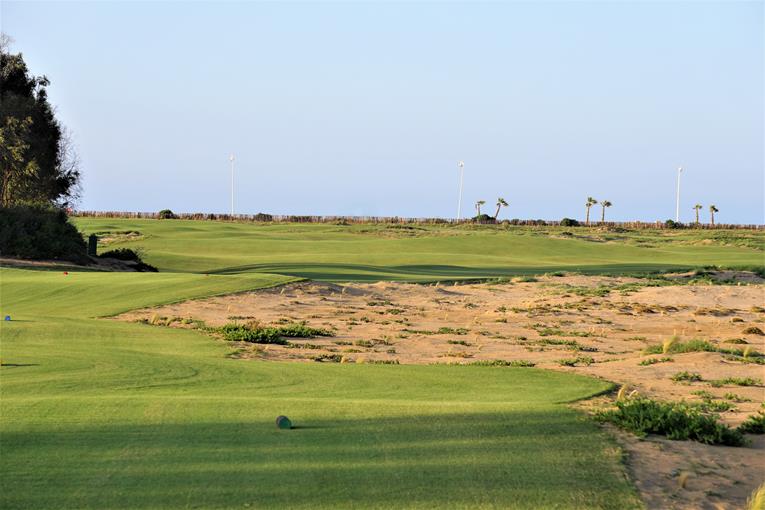
The practice area is just to the left but who wants to practice when the view down the dogleg left 1st is so enticing?! The red flag on the green peeks out from the sea brush on the left.
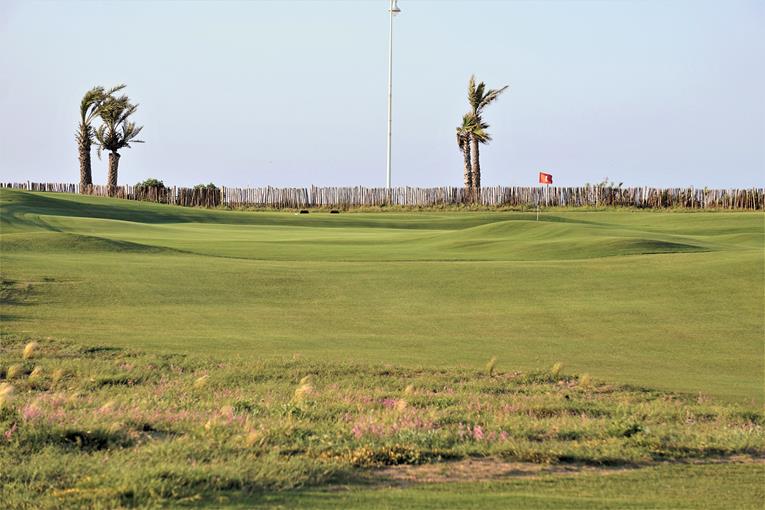
A fine drive to the inside of the dogleg sets up this approach to a right hole location. No bunker required.
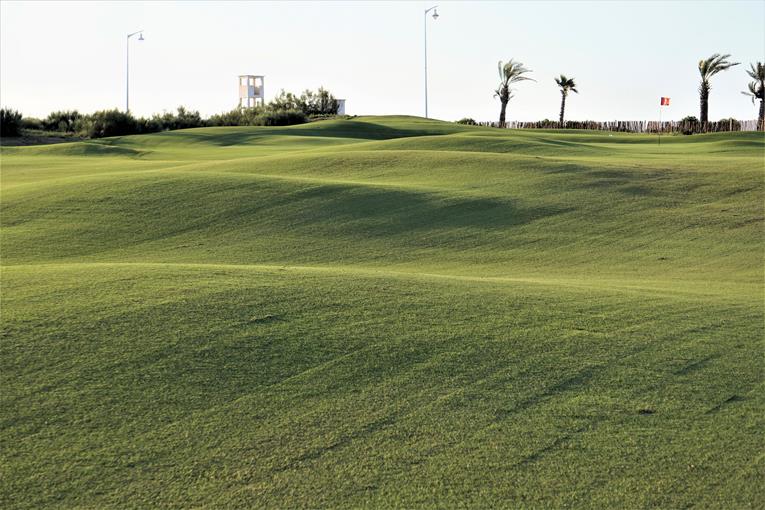
The 1st green is nestled in a sea of rumpled land – the ‘miss’ to right hole location is actually to the right. Meanwhile, …
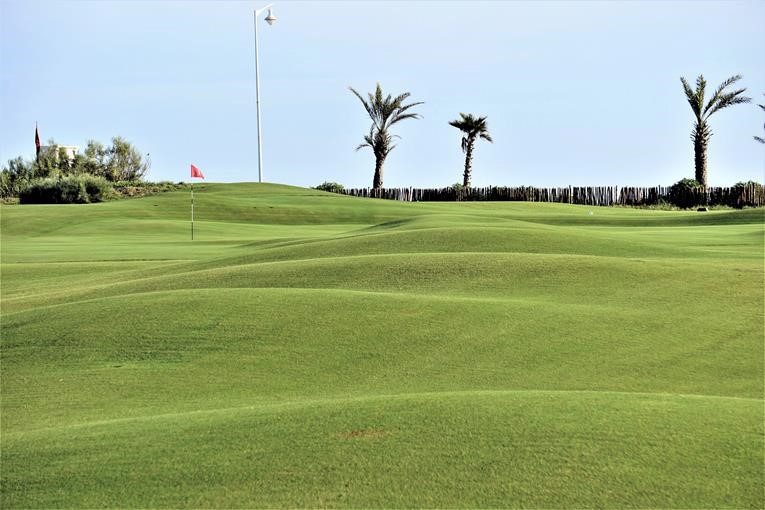
… when the hole is left, this attractive punchbowl affords numerous ways for the golfer to work the day’s first approach shot close.
Second hole, 270 yards, Beachgrass; When pressed, Joakimides considers this his favorite hole. Certainly, the setting is special as it parallels the boardwalk along Saïdia beach and the golf capitalizes on the grand setting. The green complex is of the punchbowl variety and is angled 45 degrees, running front left to back right. The nearer one drives to the trouble left, the better the angle of approach. Like Javier Arana in nearby Spain, Joakimides likes angled greens – and deep ones – as they immediately lend any hole undying playing strategy. Time and time again at Teelal, the best play isn’t to aim directly at the flag. Rather, the golfer benefits by surveying the situation and discerning opportunities to use short grass on the high side to work a ball close. Instead of tedious point to point golf, Teelal embraces the concept of hitting toward X to end up by Y, a much more entertaining and thought provoking brand of golf. In this design regard, Teelal is similar to Tobacco Road in North Carolina, a course that Joakimides visited during construction and that he credits for helping him dare to be bold.
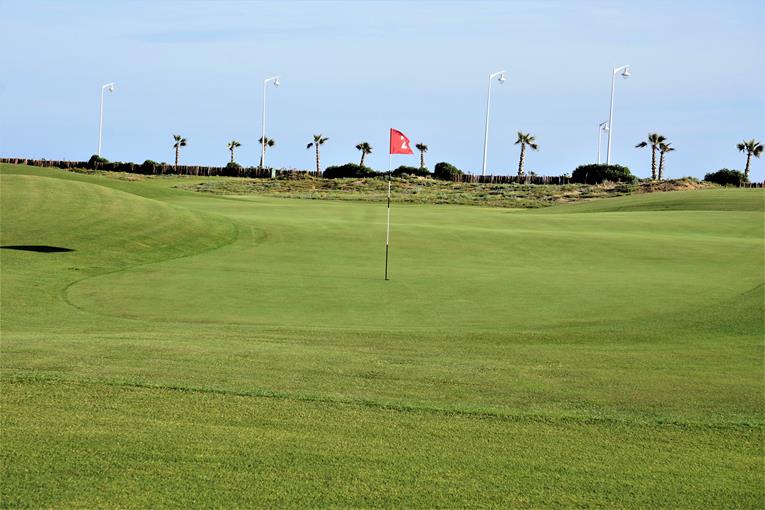
As seen from behind, the 2nd green is not only long but falls from front to back. Everyone will likely drive it near the green but the green complex is adept at turning two shots into three.
Third hole, 270 yards, Triple; The second and third holes represent an unusual combination; the author can think of no other quality course that begins with two drivable short two shotters among the first three holes. Hopefully, pace of play won’t prove problematic. With that noted, the second and third could not be more different. The second green is much longer than wide and gathers balls; the third green is the mirror opposite with a hogback in the middle of a putting surface that is wider than it is deep. Everything melts off the sides at the third.
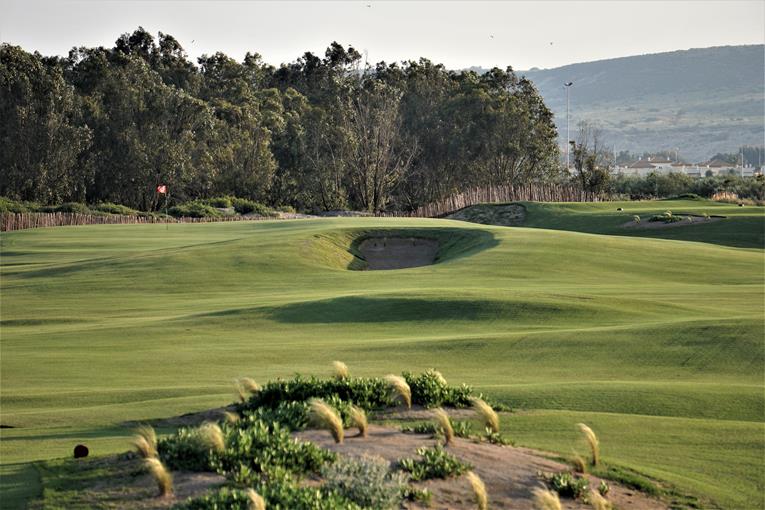
The pit 20 yards short of the green captures the eye but it is the spine through the middle of the green that provides unending headaches.

Hole locations to the right of the spine are more problematic and are among the hardest on the course.
Fourth hole, 175 yards, Blowout; Professional golfers, like Joakimides, have much better control of their distance than amateurs. Their misses tend to be left/right versus short/long. Therefore, Joakimides reasons that penal fronting bunkers are much more of a hazard for the duff than the tiger. He typically eschews such but to altogether avoid them would rob variety. On the handful of holes where he opts to employ fronting bunkers snug against the green (here, the sixth, ninth, and fourteenth holes), a path is provided for approaches to skirt around the hazards.
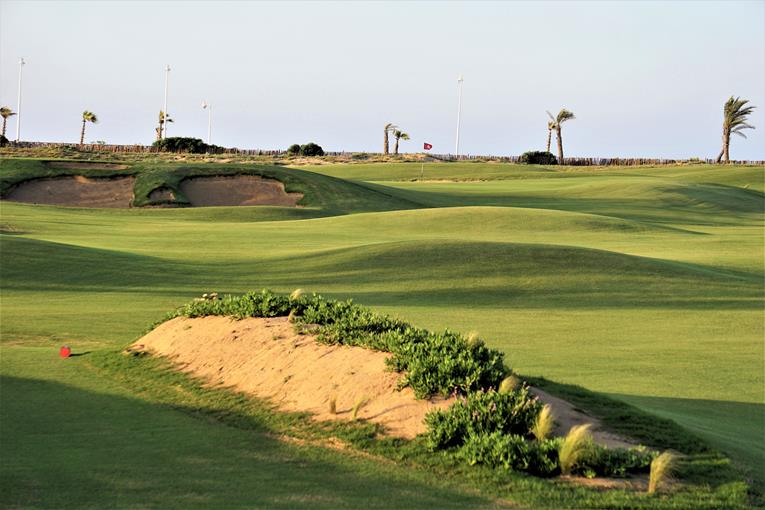
The fourth hole with its right hole location, which seems a lot more user friendly than the left ones.
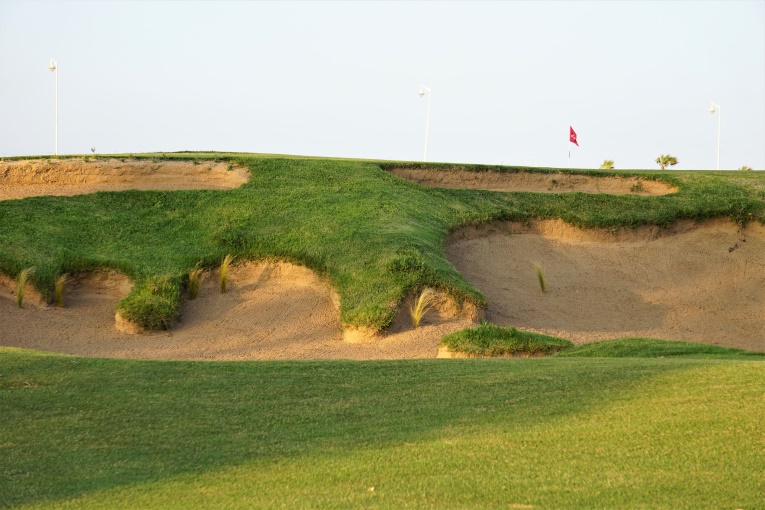
The deep front left bunker(s) in May, 2018, six months before the course opens. Vegetation is being added, and the small oblong trench bunkers on top are a menacingly distinctive attribute.
Fifth hole, 320 yards, Downhill; The tee placed at an angle to the fairway creates a most appealing drive but the green acts as the real defense. A high right front knob gives way to a long slender green that tilts right to left and features a Biarritz styled swale through its front third. Its the only Biarritz feature with a tilt that the author can recall and it acts as a funnel, sucking balls in and scuttling them down the green’s tightly mown left bank. Forward hole locations can be particularly ticklish as an approach slightly long finds the swale … and the ball is gone.
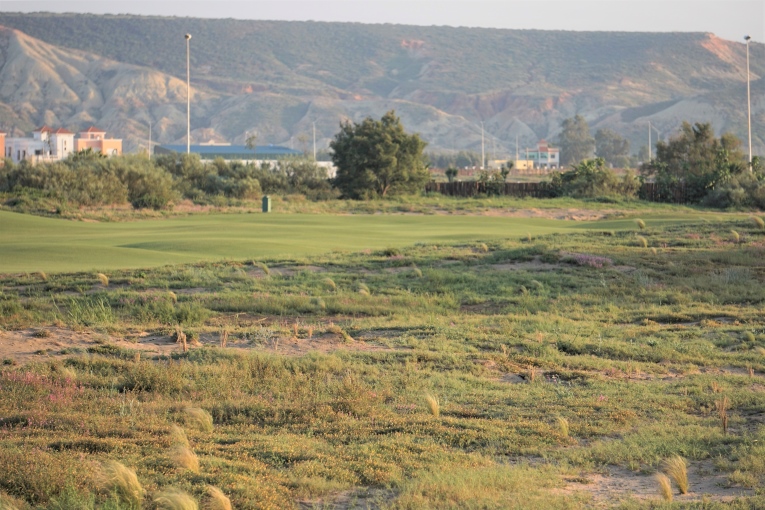
The back markers are offset to the fairway, creating a fine diagonal tee ball over the native sandy floor.

For irritation, there is nothing better than a high front to a green. Just ask anyone who has played The Old Course at St. Andrews.
Sixth hole, 380 yards, Plateau; After the fifth, the golfer crosses the road and returns to the clubhouse side of the property, away from the water. The golf needs to be engaging straightaway or the golfer will feel regret. Joakimides delivers by featuring the same appealing two to four feet ground contours and by producing one interesting green complex after another. Nicolas paid me a visit in Southern Pines, North Carolina in the winter of 2017 when completing a tour of the Southeastern United States, from Streamsong in Florida to Tobacco Road in North Carolina. When I first saw the long plateau sixth green (55 yards wide and only 17 yards deep), thoughts of Mike Strantz’s slender greens at nearby Tobacco Road (e.g. the first, sixth, thirteenth, and seventeenth) sprang to mind. Asked if this green had been a product of that trip, Nicolas responded, yes and no in that the green he had in mind was the fourth at Streamsong Red, where Coore & Crenshaw had punctured a long green with a solitary bunker. The hole’s entire strategy stems from that bunker and the day’s hole location.

Though the golfer has left the seaside portion of the property, note how the small dunes are carried through. Today’s right hole location signifies to the golfer standing on the tee to drive down the right side of the fairway.
continued >>>
Teelal – Golf Saïdia
Morocco
Ninth hole, 500 yards, Boomerang; Making the second shot matter on a par 5 is an architect’s duty. Even on Golden Age courses, too often the second shot devolves into merely advancing the ball some 200 yards down the middle of the fairway. That constitutes dull golf. One way to imbue lasting strategy into a three shotter is to crown it with a boomerang green that wraps around a central pit. In this manner, the golfer needs to be cognizant of the hole’s location and direct his second shot appropriately to the side of the pit the hole is located. George Thomas unveiled this concept at the first at Riviera, then Gil Hanse and Geoff Shackelford borrowed it for their thirteenth at Rustic Canyon, and now you can find a delightful rendition in … Morocco!

… the greenside one where a good player can readily use the steeply banked green to escape without undue harm.
Tenth hole, 480 yards, Algeria; The rotation of what is asked of the golfer is excellent. As previously detailed, the second and third greens could not be more different and the approach to the long slender fifth is followed by one to the uber-wide but shallow sixth. Here we go again: compare the large ninth green with its boomerang and steep banks to the crowned tenth which falls away on all sides. Though this is the longest two shotter on the course, it plays to the smallest green. Downwind, the landing zone becomes an area ~twenty to thirty yards short of the green from where the ball can bumble along the ground and onto the open putting surface (i.e. in fine contrast to the aerial approach at nine).
Eleventh hole, 490 yards, Split; Homes per se aren’t the enemy of golf course architecture, it is the resultant lack of playing width that comes from residential areas that renders countless such courses devoid of much interest. Here, Joakimides inherited a routing done several years ago by another architect and by the time course construction commenced homes had been built right and left. The good news here at eleven is that the playing corridor measures a whopping 160 yards from edge to edge. In fact, the original architect intended two holes to play back and forth in the same playing corridor that Joakimides only built one! With loads of room at his disposal, Joakimides designed a fairway that splits left and right around a dune. The shorter, more advantageous route to the right comprises the narrower passage.

The above dune is the author’s very favorite sort of hazard, as it is centerline and surrounded by short grass, so it plays even bigger than it looks. Like any truly great hazard, it is always in play.
Twelfth hole, 355 yards, Wooden Fence; Why hire an architect at the beginning of his career? Attention to detail is one reason. More likely than not he won’t be working elsewhere and a developer can rely on him to be on site and to get the fine points right. That is precisely what occurred here with Joakimides’s inspired selection of wood fencing. It can be seen around the border of the property, especially at the first three holes and here. The wooden stakes, all the course signs, and benches are made from Eucalyptus, an abundant local wood. Joakimides used the stakes to create an abrupt linear line left that has a jarring effect similar to the cops at Hoylake. Left is out of bounds but alas, that’s the side the golfer hopes his tee ball finishes. A deep bunker front right and the tilted green complex (whose right side is eight feet (!) higher than the left) mean that a tee ball played long left provides a stark advantage for the next shot over a tee ball played one safely right. The tension created by the rustic fencing is excellent, especially coming on the heels of the large scale eleventh.
Fifteenth hole, 525 yards, Angles; The course ends with a reachable par five, a medium length two-shorter, another reachable par five and a bumptious four par. All sorts of outcomes are possible at this highly entertaining finish. Again, there is tremendous variety: the fifteenth green lies in a field, sixteen sits behind a stone wall, the seventeenth is defended by two mounds and the Home hole is located behind an offset, sleepered bunker. At both three shotters, the devil is in how the rear of the green is lower than the front. Joakimides clearly avoids the mistake that Max Behr groused about that too many greens slope prosaically from back to front with such monotony requiring little thought. At Teelal the golfer needs to de-program what he’s become accustomed to at less inspired designs. A bowl or thumb print eats up the middle back section of the fifteenth green, creating left and right wings. The higher level of the green becomes a reverse boomerang, giving way to a lower bowl. Wherever the hole is located, the peril of going a smidgen long and being sucked into the bowl is present. Outstanding architecture.

The sketch shows how the hole got its name ‘Angles’, as the back bowl creates all sorts of intriguing hole locations.

This view from the clubhouse across the Home green captures the soon to be infamous back bowl in the 15th green.
Sixteenth hole, 390 yards, Wall; Joakimides is quick to praise the resort and his friend, the General Manager. He notes, ‘I had no restrictions except the clubhouse position. For example, they were okay to build a 400 yards long stone wall as long as I was within the budget. I just needed to justify that length which gives the course an old world feel right away.’ One might think that North Berwick and its walls played a critical role in the creation of this hole but one would be wrong: Joakimides is going to see North Berwick for the very first time in July 2018, a year after the course was built! Nonetheless, the wall fulfills his hope: not only does it lend the hole an old school ambiance, it makes the sixteenth standout in the golfer’s mind long after the round is concluded.
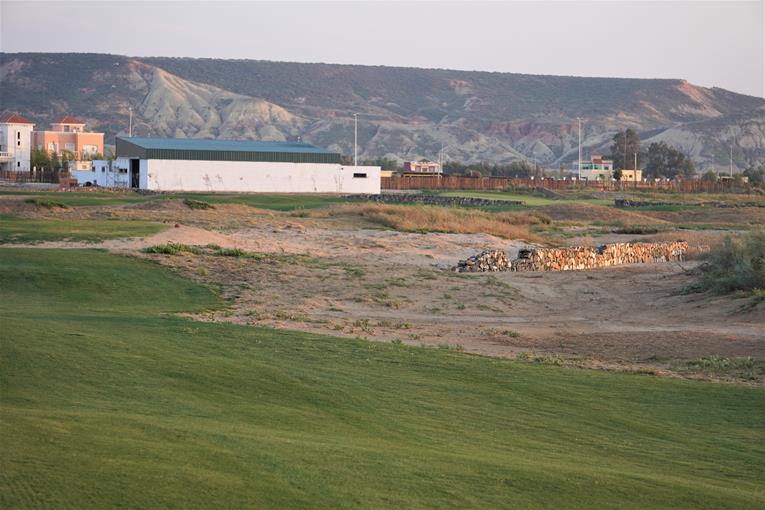
The sixteenth where the sun glints off the newly constructed stone wall bends right over broken ground. A white maintenance building in the background will soon be shrouded by vegetation (and the sooner, the better).
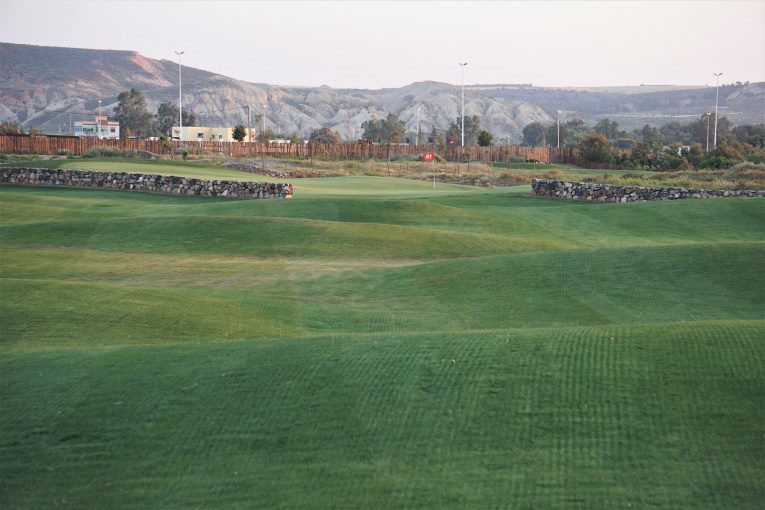
… provides playing flexibility as well as revealing one of the course’s more rolling putting surfaces.
Seventeenth hole, 475 yards, Hidden; Several of the author’s favorite three shotters (eighteen at Yeamans Hall, fifteen at St. Louis Country Club and six at Piping Rock) become measurably harder when upper back hole locations are employed. The reason for that is twofold: the holes become 30+ yards longer and the targets are narrowed. Teelal’s penultimate hole is similar in that back hole locations become more difficult but for wildly different reasons. Forward hole locations are in the cleavage between two mounds and enjoy a punchbowl effect whereby balls gather but the green expands left and right behind those mounds as it stair-steps down two feet to a lower section. These back hole locations are more exacting and difficult to judge since the base of the flag stick is always ‘hidden’ from view.
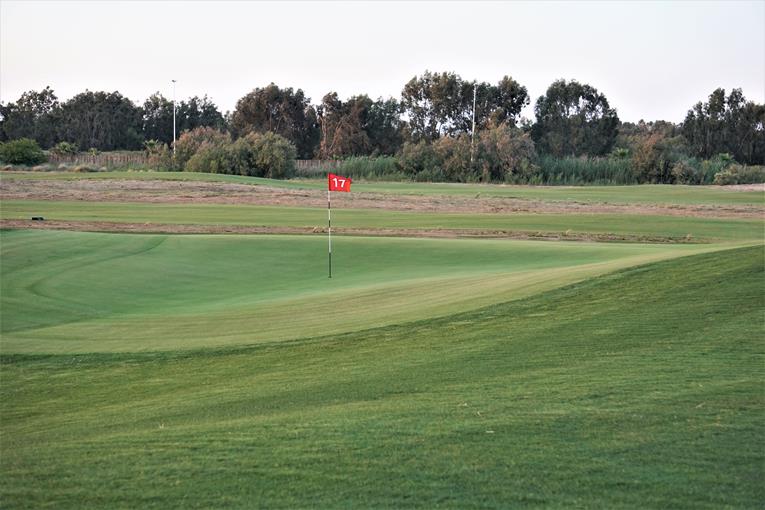
Lots of good can occur to the golfer when the forward hole locations are used. The majority of the green is out of sight, over the ridge.
Eighteenth hole, 465 yards, Rabbit Holes; For variety’s sake, the best finishing hole for any course is the opposite of what has preceded it. If the course features a bunch of tough two shotters, what’s a better finish than the Home holes at Prestwick and St. Andrews? Conversely if the course isn’t overly long, then a brute of a two shotter cements the challenge at places like St. Enodoc and Eastward Ho! So it goes here, a 1/2 par hole that falls on the tough side goes opposite to and parallels the tenth, the other 450+ yarder on this side. One of the two is guaranteed to play uncommonly difficult in the windy environment. The Golden Age design tenet of giving the player room off the tee and then stiffening the challenge at the green is marvelously embraced at Teelal.
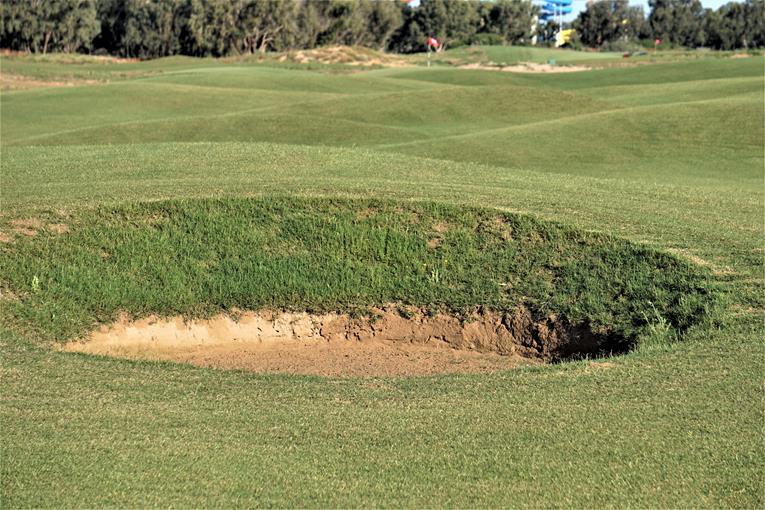
What an appealing golf scene! The Old Trooper delights in the random landforms before tackling the most demanding approach shot of the day.
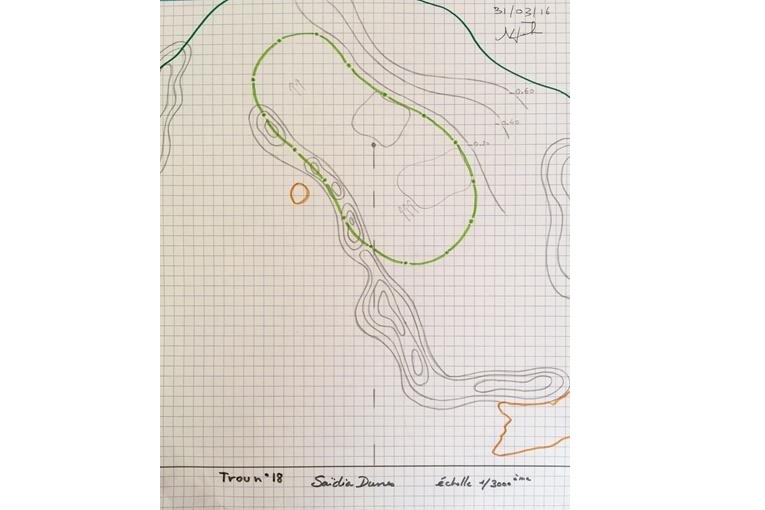
Joakimides’s sketch displays the angled green that best accepts approach shots from the right center of the fairway. Even though the fairways are broad at Teelal, position matters.
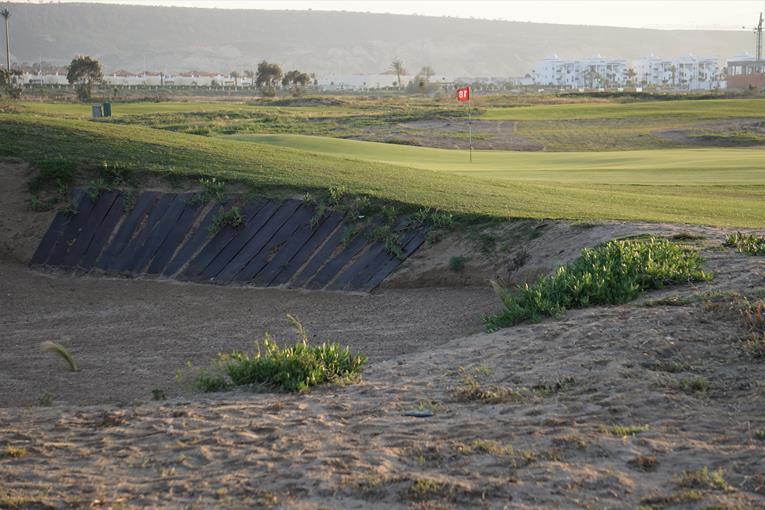
This fierce, sleepered bunker lurks twenty paces shy of the putting surface and complicates approach shots played from too far right.
Walking off the course, the golfer appreciates that he’s just played a course with an inordinate number of half par holes. Be it the drivable par fours early in the round, the four reachable par fives or the beastly eighth, tenth and eighteenth holes, the golfer is frequently asked to hit a green from 200 to 280 yards out. A player’s woods, long irons and hybrids get a work out, which isn’t usually the case for a course that measures just over 6,700 yards from the back markers. Arguably, one of the most fun aspects to the round is the slow motion manner in which these long approach shots play out. From watching a downwind tee ball at the second ride high onto the left greenside mound before swooping down to the putting surface or wondering where your approach finally settled on the back lower shelf at seventeen, the golfer attention is rapt.
When one thinks of Morocco, names like Casablanca and Marrakesh spring to mind. Saïdia is a newer offering and joins the Palace Course behind the King’s wall in Agadir and the historic Royal Dar Es Salam in Rabat as the nation’s three most compelling golf destinations. Enthusiasts of the sport will delight in experiencing the fun, time-honored design features that the French architect elected to build into the ground. Joakimides scrupulously and audaciously fashioned a corner of a third world country into his well-developed concept of ideal golf. It’s a distillation of the man’s playing experiences around the world and his contemplative reflection about what constitutes good golf. The General Manager took a chance and his faith has been handsomely rewarded with a refreshingly fun brand of golf that will stand the test of time.





